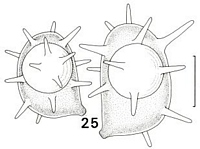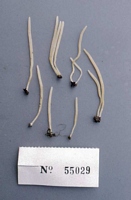|
 Clavaria gibbsiae Clavaria gibbsiae
SynonymsClavaria pallidoechinulata
BiostatusPresent in region - Indigenous. Non endemic
Images (click to enlarge)
Caption: Fig. 25 Clavaria gibbsiae TENN no. 42197. Scale bar = 5 µm. | 
Caption: Microfiche 1-17. Clavaria gibbsiae. TENN 43550. |
Article: Petersen, R.H. (1988). The clavarioid fungi of New Zealand. New Zealand Department of Scientific and Industrial Research, Bulletin 236: 170 pp. Wellington:.
Description: Fruit bodies up to 70 x 3.5 mm, simple clubs, scattered to cespitose in small groups (up to 4),
narrowly fusiform to narrowly cylindrical. Stipe arising from a small, white mycelial pad,
terete, appearing silky-striate, off-white, ivory ("pale cinnamon-pink") or very pale yellow-olive ("cream-buff", "cartridge-buff",
"olive-buff", "ivory-yellow"). Club terete to slightly
sulcate, appearing waxy, off-white to cream, ivory or pale yellow-olive ("pale olive-buff",
"olive-buff", "deep olive-buff"); apex sometimes slightly darker ("Isabella color"), rounded.
Taste and odour very mildly to strongly of garlic.
Tramal hyphae of two types: (i) generative, inflated, thin-walled, clampless, strictly parallel,
free, tightly packed; secondary septa common; and (ii) gloeoplerous hyphae, uninflated,
refringent, occasional. Subhymenium well-developed, pseudoparenchymatous. Hymenium
thickening; basidia 45-55 x 10 µm, clavate, clamped; contents densely multiguttulate at
maturity, the guttules highly refringent; sterigmata 4, up to 9 µm long, stout, straight.
Spores 7.6-10.8 x 6.1-7.2 µm (E = 1.17-1.67; Em = 1.32; Lm = 8.42 µm), subglobose to
broadly ellipsoid or broadly ovate, thin-walled, smooth through much of their development,
finally grossly spiny; contents uniguttulate at maturity; hilar appendix prominent, papillate;
ornamentation of narrowly conical spines up to 4 µm long, distributed over all of the spore
surface.
Habitat: On soil and humus under Weinmannia, Dacrydium, and Beilschmiedia.
Notes: Some may question why this epithet has been used to represent a spiny-spored taxon, but I
have examined the type specimen (K - Dutch N.W. New Guinea, i. 1914, coil. L.S. Gibbs,
no. 6174) and have found such ornamented spores. A description of the type specimen
follows.
Fruit bodies up to 34 x 2 mm (all incomplete), simple clubs, cylindrical, some cespitose in a
cluster. Stipe now dull deep orange, cartilaginous, covered below with a fine pruina. Club
now clearly distinct from stipe, opaque, covered with a fine "bloom."
Tramal hyphae of club up to 19 µm diam., inflated, thin-walled, hyaline, without clamp
connections, parallel, adherent. Subhymenium rudimentary, crushed; hyphae up to 8 µm
diam. Basidia 40-45 x 7-8 µm, clavate, clamped.
Spores 10.4-12.2 x 6.8-8.3 µm (E = 1.32-1.48; Em = 1.40; Lm = 10.73 µm), ellipsoid to
broadly ellipsoid, thin-walled, hyaline; contents opalescent; hilar appendix papillate, broad;
ornamentation of slender, awl-shaped spines up to 1.5 µm long, developed late in spore
ontogeny.
I have not been able to read Ramsbottom's original description, but Corner (1950; p. 241)
repeated Ramsbottom's report: spores 7-11 x 4.6 µm, basidia 2-sterigmate. Furthermore,
Corner stated his observations on the "co-type collection of Miss Gibbs in the Kew
herbarium" (presumably the specimen described above): "I found abundant spores 9-10.5 x
7-8 µm and many clearly 4-spored, rather broadly clavate basidia: the hyphae were rather
short-celled, -15 µm wide, without clamps".
Indeed, in my examination, I selected only spores which seemed well-preserved (refringent
under phase contrast). They were the largest of the many spores present, and my
measurements and statistics reflect this. If spores were chosen at random. Corner's
measurements would be accurate. At the same time, individual spores of all sizes clearly
show slender spines.
Corner's illustration (1950; p. 239, text fig. 82) of Clavaria gibbsiae is not like the type
specimen, being too stout. Instead, if the fruit bodies in text fig. 83 (C. gibbsiae var. tennis)
were gathered into a single fascicle, they would closely approximate the type specimen of the
species.
With the type specimen of C. gibbsiae showing spiny spores, the nomenclature of its
infraspecific taxa, var. tenuis (f. tenuis ), var. tennis f. microspora, and var. megaspora,
must be questioned. Variety tenuis f. microspora must be considered to be spiny-spored, and I
treat it as synonymous with C. echino-olivacea. Variety tenuis (f. tenuis ) is here treated
under C. albo-globospora, and var. megaspora under Clavaria Taxon no. 5.
As in other spiny-spored taxa described here, the spores of C. gibbsiae develop their
ornamentation late in development. Most spores in microscopic mounts are smooth, but
spores with short spines are also seen, as are those with completely - formed ornamentation.
Unfortunately, no spore prints of these taxa were gathered; such material would reveal
whether both smooth and ornamented spores are released, and, if so, in what proportions.
Clavaria californica Pet. has several characters in common with C. gibbsiae including pale
fruit bodies, clamped basidia, and spiny spores. Its fruit bodies are off-white to pale yellow,
however, its spore's arc somewhat smaller and with much less distinct ornamentation, and it
lacks the odour of garlic.
Based on one season's collecting, this taxon was named C. "albo-echinulata", for all fruit
bodies gathered were white or off-white. Additional collections, however, showed colour
variation similar to that also found in C. ypsilonidia (q. v.), and to a lesser extent, in C.
echino-olivacea. I have, therefore, placed faith in micro morphological characters at the
expense of gross morphology.
The differences between C. gibbsiae and C. echino-olivacea are subtle, and not always easily
observed. Fruit bodies of both taxa vary somewhat in colour, making distinctions even more
difficult, but fresh fruit bodies of C. gibbsiae smell of garlic, especially when kept for 1 or 2
hours in a closed container, whereas those of C. echino-olivacea do not. With dried material,
spore dimensions (especially width) differ, and therefore so does the Em. Even more subtle
differences can be seen in the quality of hymenial congestion and guttulation of mature
basidia, but one must have mounts of both taxa side by side to observe these.
|